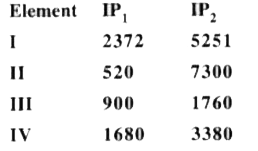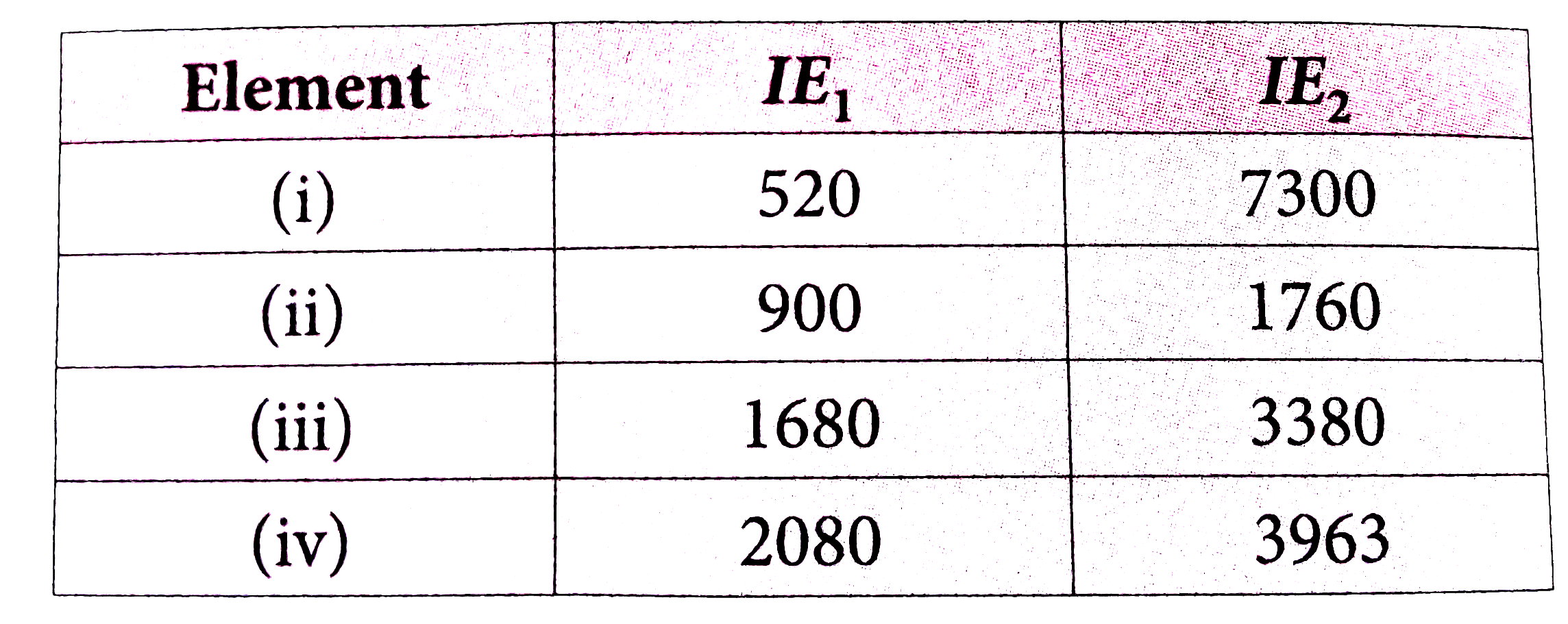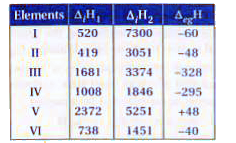The first IE and second IE (Kjmol−1) and da<aegH(kJmol−1) of a few elements are given below:
 Which of the above is likely to be the least reactive non-metal Solution in Malayalam
Which of the above is likely to be the least reactive non-metal Solution in Malayalam
Element IV (¬sohighIE1andhigh¬ativeδegH)
Topper's Solved these Questions
Similar Questions
Write the Lewis dot structure of CO molecule.
View SolutionDefine environmental chemistry.
01:44View SolutionThe first (ΔIH1) and second (ΔIH2) ionisation enthalpies (in kJ mol−1) and the (ΔegH) electron gain enthalpy (in kJ mol−1) of a few elements are given below:

The least reactive element is :02:44View SolutionWhich represents alkali metals (i.e. 1^(st) group metals) based on (IE)_(1) and (IE)_(2) value (in KJ//mol) ?
04:33View SolutionFirst and second ionisation enthalpies(in KJ/mol) of few elements are given below: Which of the above elements will form halides with formula MX_(2) ?
View SolutionThe first (IE1) and second (IE2) ionisation enthalpies (kJ mol−1) of a few elements designated by Roman numerals are shown below.
IE1IF2I23725251III9001760 IE1IE2II5207300IV16803380
Which of the above element is likely to be:
a reactive non-metalView SolutionThe first (IE1) and the second (IE2) ionization enthalpies (kJ mol−1) of a few elements designated by Roman numerals are shown below:
ElementIE1IE2I23725251II5207300III9001760III9001760IV16803380
Which of the above elements is likely to be a,
reactive non metalView SolutionThe first (IE1) and second (IE2) ionisation enthalpies (kJ mol−1) of a few elements designated by Roman numerals are shown below.
IE1IF2I23725251III9001760 IE1IE2II5207300IV16803380
Which of the above element is likely to be:
a reactive non-metal13:44View SolutionThe first (IE_1) and the second (IE_2) ionization enthalpies ("kJ mol"^(-1)) of a few elements designated by Roman numerals are shown below: {:(,"Element",IE_(1),IE_(2)),(,I,2372,5251),(,II,520,7300),(,III,900,1760),(,III,900,1760),(,IV,1680,3380):} Which of the above elements is likely to be a, reactive non metal
01:23View SolutionThe first (Delta_(i)H_(1)) and second (Delta_(i)H_(2)) ionization enthalpies ("in kJ mol"^(-1)) and the electron gain enthalpy (Delta_(eg)H)("in kJ mol"^(-1)) of the elements I, II, III, IV and V are given below the least reactive non - metal and the most reactive metal of these are respectively
01:38View SolutionThe first (IP1) and the second (IP2) ionisation potential (kJ mol 1) of a few elements designed by roman numerals are shown below

Identify the element which are likely to be a noble gas and a reactive metal respectivelyView SolutionFirst and second ionisation enthalpies(in KJ/mol) of few elements are given below:

Which of the above elements will form halides with formula MX2?01:38View SolutionThe first (ΔiH1) and the second (ΔiH2) ionization enthalpies (in kJ mol−1) and the (ΔegH) electron gain enthalpy (in kJ mol −1) of a few elements are given below :

Which of the above elements is likely to be :
(a) the least reactive element.
(b) the most reactive metal.
(c) the most reactive non-metal.
(d) the least reactive non-metal.
(e) the metal which can form a stable binary halide of the formula MX2 , (X = halogen).
(f) the metal which can form a predominantly stable covalent halide of the formula MX (X = halogen)?01:19View SolutionThe first IE and second IE (Kj mol^(-1)) and dalta_egH(kJ mol^(-1)) of a few elements are given below: Which of the above is likely to be the least reactive element
01:21View SolutionThe first IE and second IE (Kj mol^(-1)) and dalta_egH(kJ mol^(-1)) of a few elements are given below: Which of the above is likely to be the metal that can from stable binary halide (MX_2)
02:13View Solution

